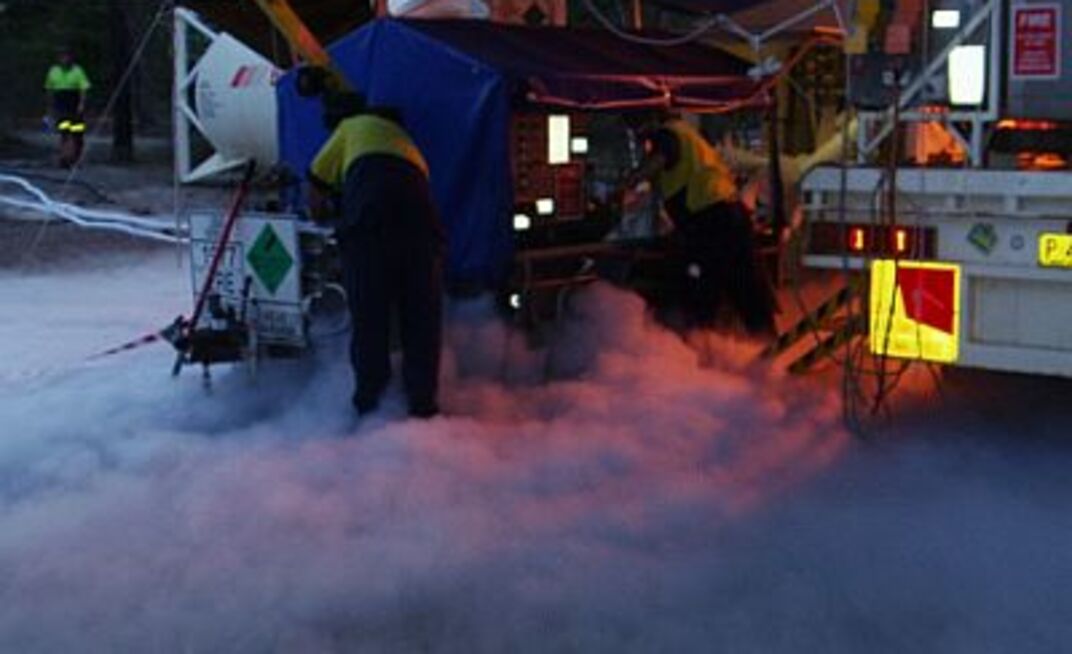Published in the May 2010 Coal USA Magazine
“An important part of our business is helping develop solutions and find the right products,” Red Dog Services president Eric Mehringer said.
Sometimes new technologies are made more attractive by mandates or regulation. An example is the final rule on “Sealing of Abandoned Areas” in coal mines, 30 CFR Part 75.335. The problem is that explosive conditions exist when the atmosphere is 5-15% methane and the oxygen level is 12% or more. So in April 2008, MSHA issued a final rule requiring the monitoring and control of atmospheres behind seals to reduce the risk of seal failure from explosion.
Section 75.336(b) (1) defines an inert atmosphere.
Areas behind seals of greater than 120psi must be monitored and inerted until new seals cure, and areas behind seals of 120psi or less must be monitored at least every seven days since changes in barometric pressure, ventilation changes, water accumulations, convergence, cracks in the strata leading to the surface etc. can moderate a sealed atmosphere. Therefore, coal mines are going to do more inertion. It’s a safety issue but also becomes a cost issue.
The most common gas used for maintaining sealed area inertion is nitrogen. Nitrogen may be obtained as a cryogenic liquid transported on tanker trucks or can now be extracted from compressed air using filter technology commonly referred to as Membrane Nitrogen Technology. Fresh air contains 78% nitrogen.
Cryogenics is good for a burst of nitrogen. A truck load with 5000 gallons of liquid nitrogen equates to about 465,000 cubic feet of vaporized nitrogen delivered in 2-3 hours. When attempting to maintain an inert atmosphere or inert a large area, especially when localized sampling is insufficient, Membrane Nitrogen Technology provides a better solution because of the greater volume and continuous flow.
With the potential of frequent or continuous maintenance of sealed atmospheres, membrane technology may be a more logical approach. “If you are using two or more truckloads of cryogenic nitrogen, the economics start to tilt toward switching to membrane technology,” Mehringer said. A nitrogen membrane unit can run 24-7, providing a continuous flow of nitrogen, and, depending on the size unit, provides much more MCFM at a lower price point. Moreover, it’s a “green” technology.
Jim Walters Resources Inc (JWR) had not used membrane technology until earlier this year when the company needed to inert behind some new permanent (120+psi) seals. JWR general manager of mining engineering Tom McNider called it a learning experience. JWR used a combination of cryogenics and membrane technologies. Cryogenics were used to shock behind the new seals and a Parker 750 SCFM membrane unit, operated by Red Dog Services, was used to provide a continuous flow to maintain readings while the seals cured. “We needed to pump a lot of nitrogen. Afterwards, when we looked at the data, we found that during the course of our project the membrane unit produced about 75 per cent of the total volume of nitrogen used at less than half the cost per MCFM of liquid cryogenics,” McNider said.
Red Dog has also been operating and maintaining membrane nitrogen generators at a Colorado Mine since September 2009. Notwithstanding the cost, trucking nitrogen into the mountains in winter is unreliable and dangerous. After purchasing units from Parker Hannifin, the mine contracted with Red Dog to keep the generators and compressors going. “The conditions up in the Colorado Mountains are extreme during the winter,” Mehringer said. “The mine needed continuous inertion, despite the temperatures and conditions on the surface. The equipment performed very well because it’s a solid technology and our staff knows what they are doing.”
Parker Hannifin’s national accounts manager, industrial nitrogen products, Mario Bolivar said coal mines are a major market for membrane nitrogen products. With tighter regulation and increased focus on safety, mine managers, safety directors and mine engineers need to understand where nitrogen membrane technology is the right solution.
“The performance and economies from membrane generated systems have developed to the point where you have to consider membrane generators,” Bolivar said. “One unit can pump into multiple bore holes and the units can be moved around. Why go to the expense to truck in liquid cryogenic nitrogen when you can take it out of the air?”
Membrane units produce nitrogen as a gas as opposed to cryogenics, which is nitrogen at low temperature in liquid form. As a gas, nitrogen can be combined with coal fire foam to enrich the liquid foam and produce a doubly potent fire-fighting technique. The foam’s consistency can be regulated by the amount of nitrogen injected to create the desired viscosity.
The foam fills the chamber, like shaving cream expanding in your hand, to cool and suffocate the fire. When the foam returns to a liquid state, its lower surface tension enhances its ability to penetrate into cracks and crevasses to find smoldering coal.
“It is ‘the’ most effective coal fire-fighting technique,” president of Thermo Pro Engineering John Walsh said. “I’d recommend using foam products specifically formulated and intended for coal, because products, like Red Dog’s K9 HP ‘Blankit’, puts out the fire and does not harm the remaining coal.”
Membrane nitrogen units are environmentally friendly and produce higher volumes of nitrogen at lower cost. They are available for daily rent, long-term lease, or purchase. Firms, such as Red Dog Services, can design emergency nitrogen use plans.
About the author: Mike Shea is chief executive and a founder of Red Dog Services, a company focused on the coal mine industry. Red Dog provides nitrogen inertion services, brokers, operates and maintains membrane nitrogen generators and responds to thermal events. Red Dog manufactures and sells specially formulated coal fire suppression foams and has solutions to prevent and extinguish coal pile fires.
























